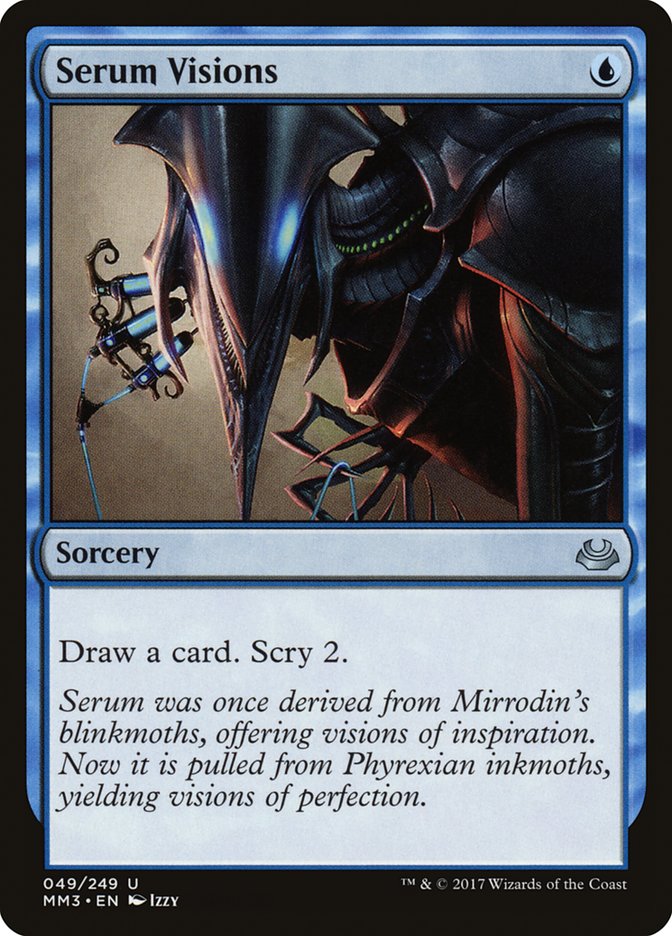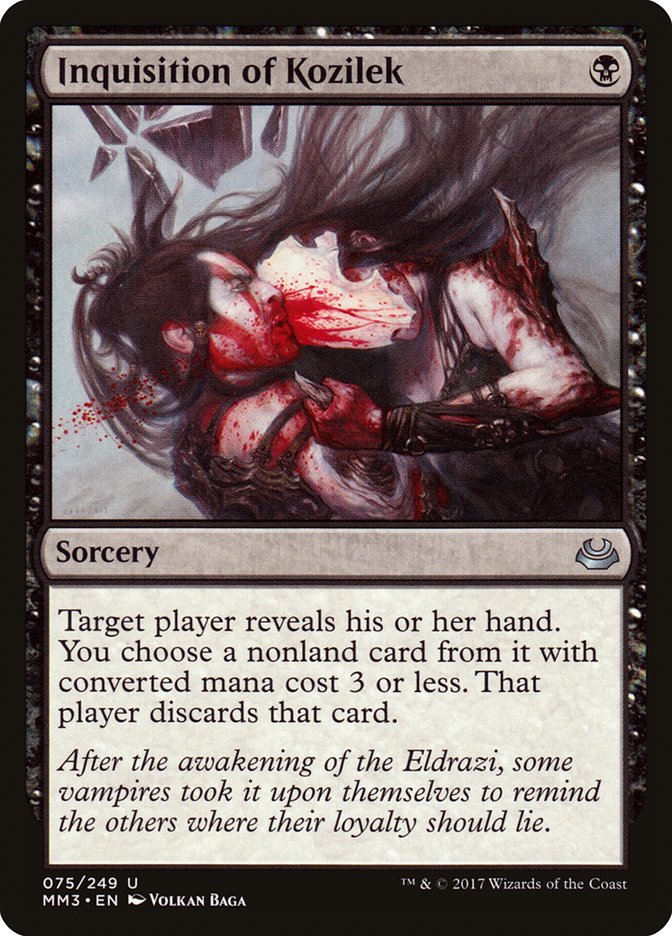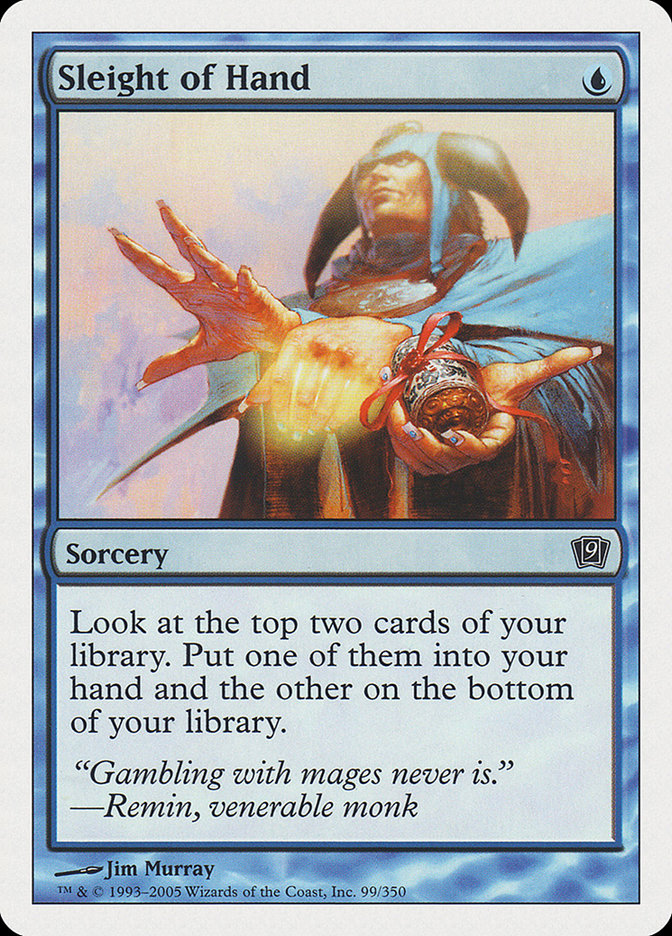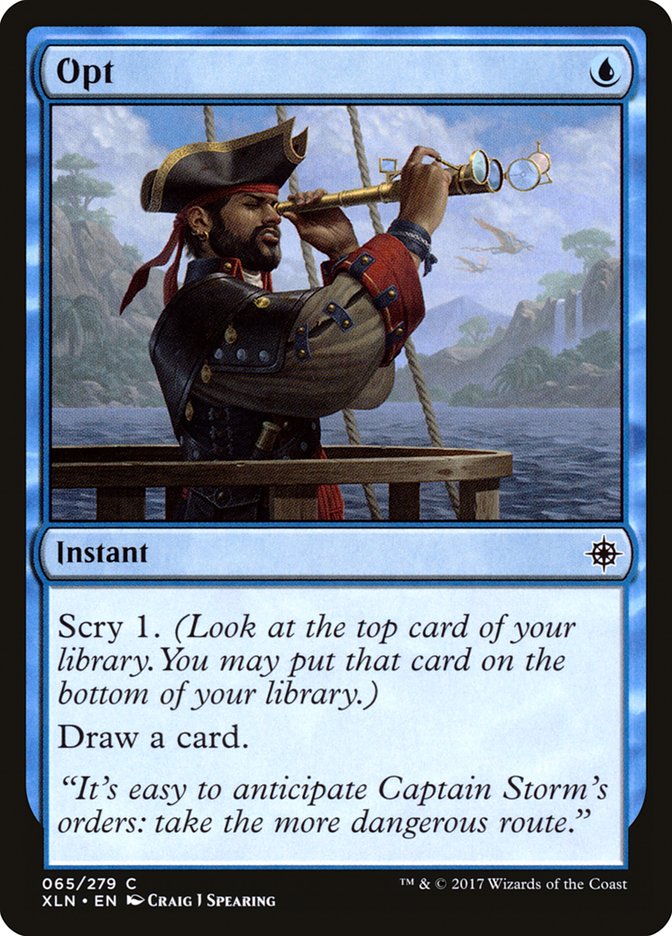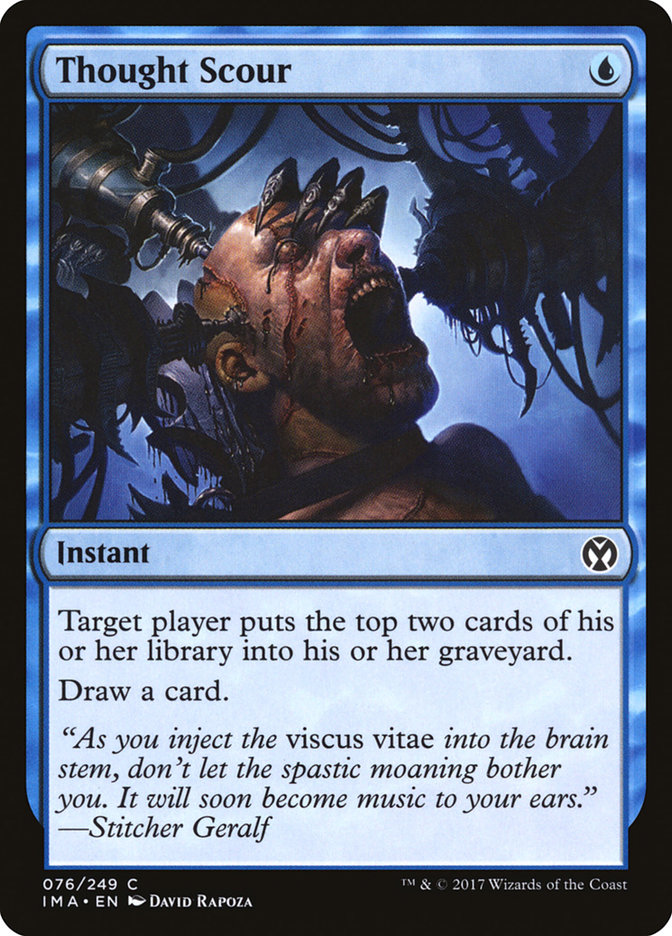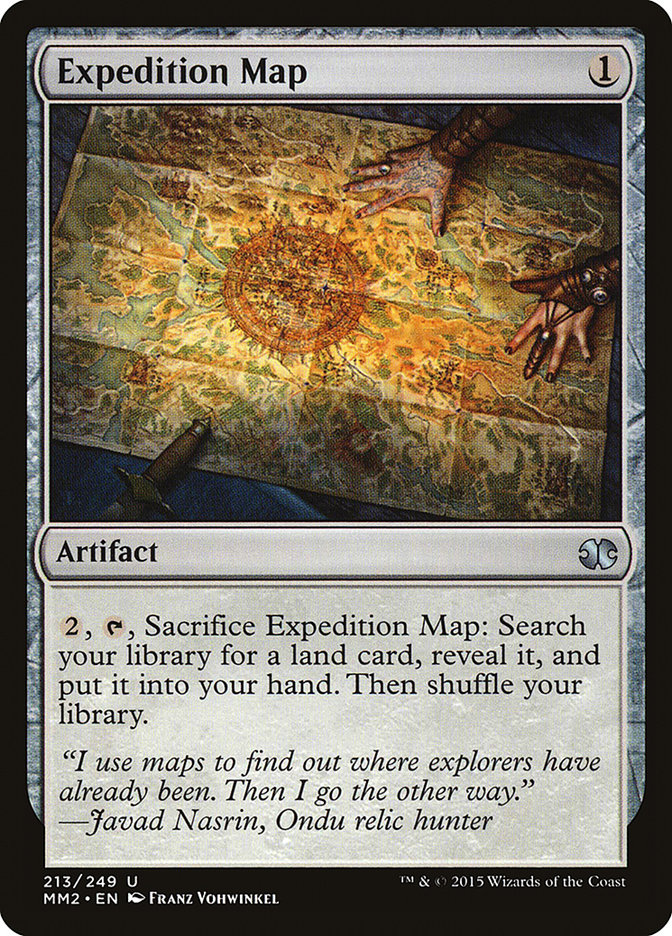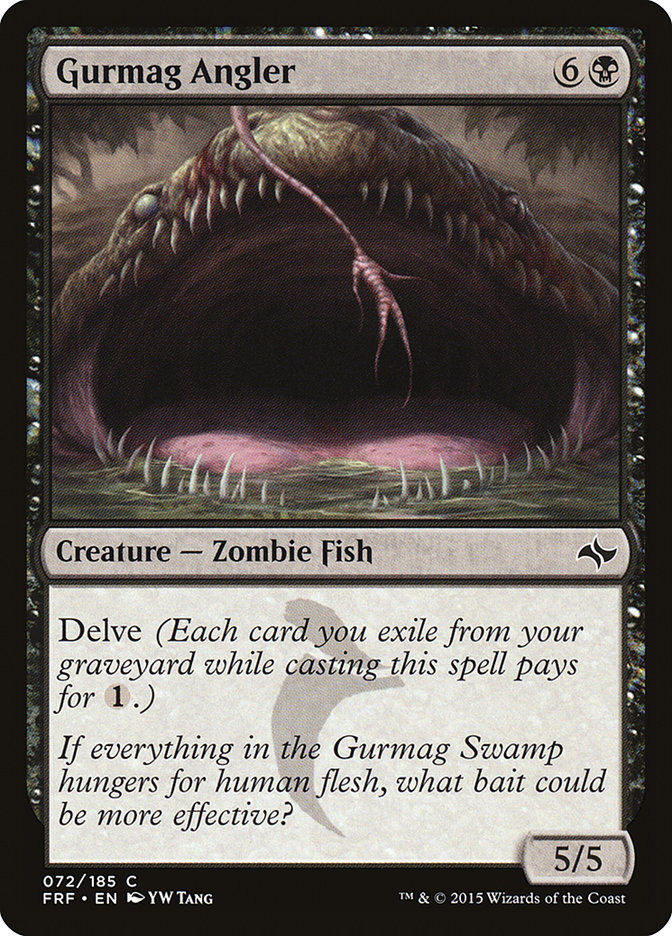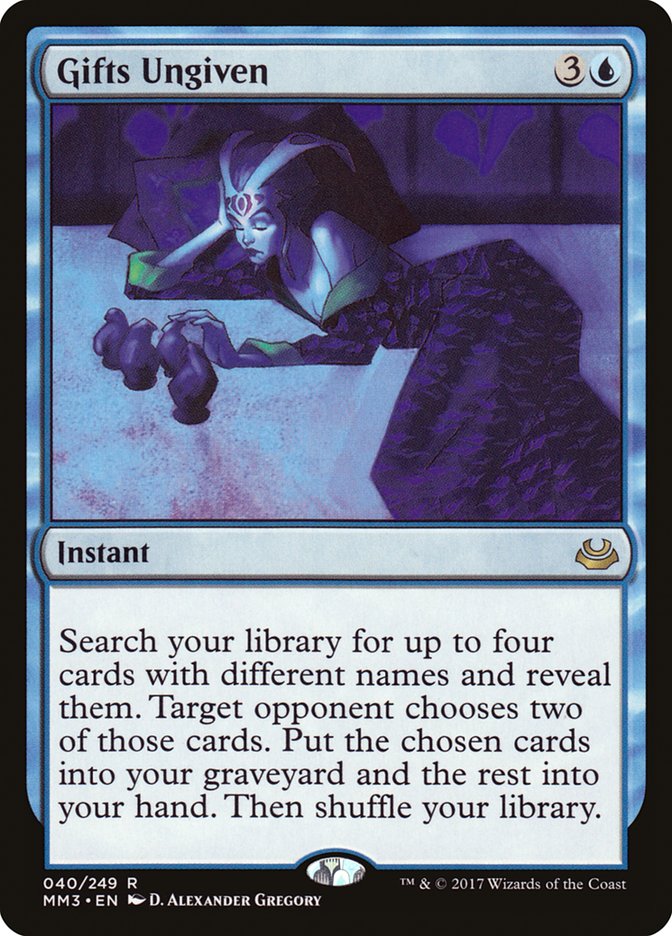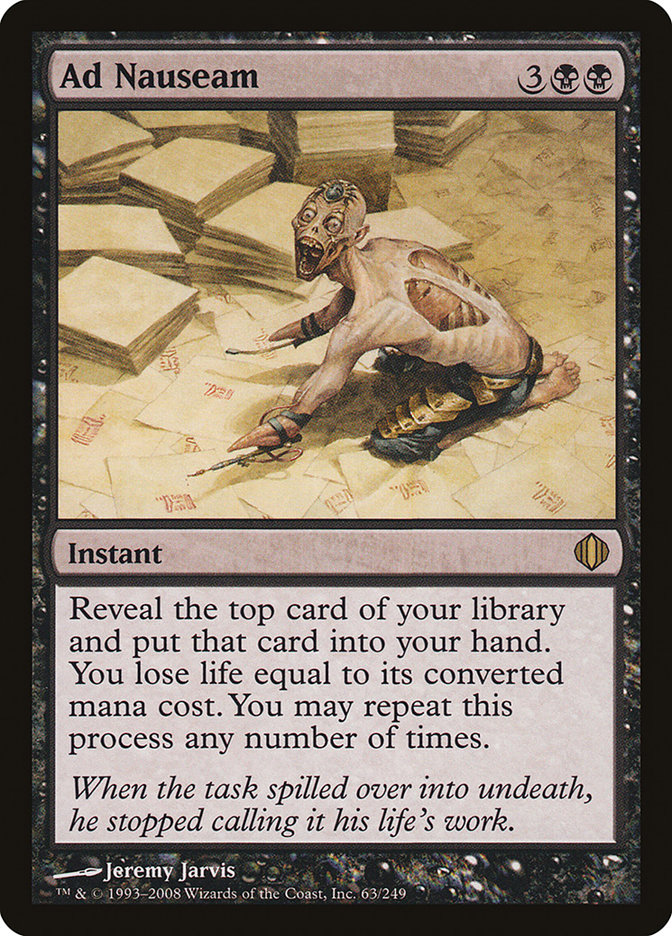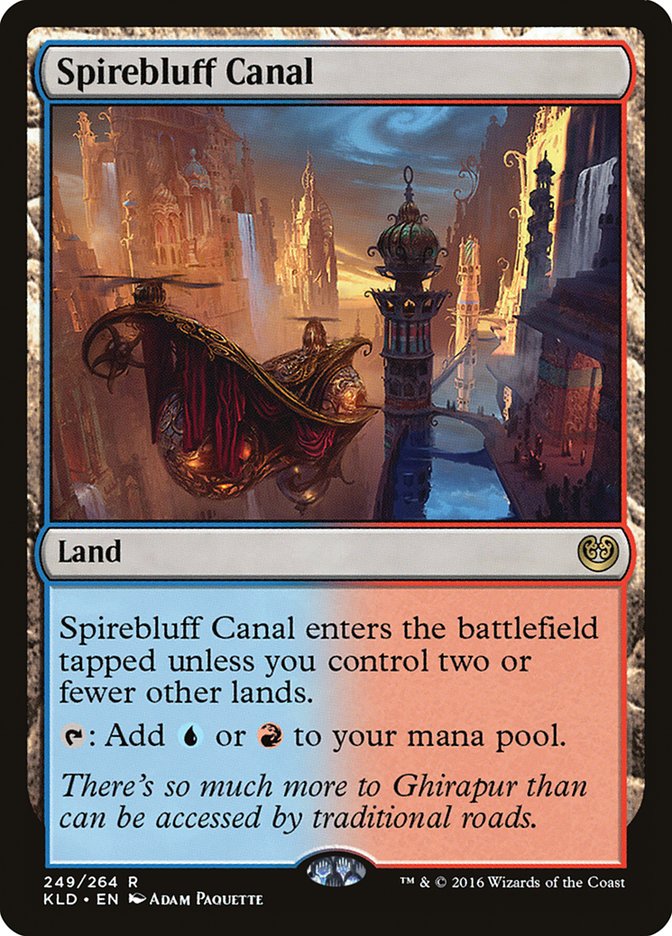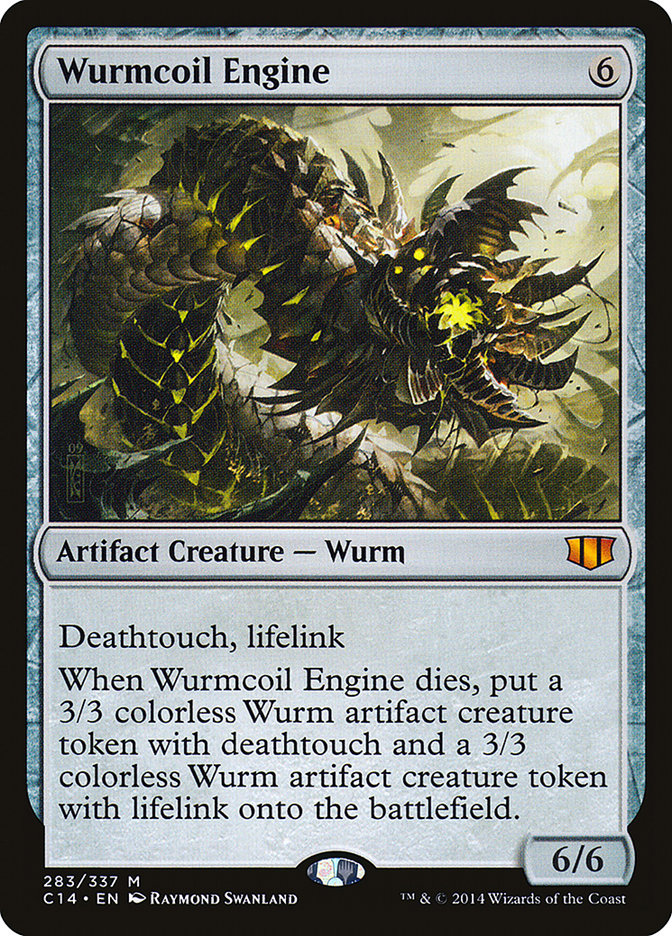Thoughtseize is the best card in Modern. Serum Visions is probably the second-best, or maybe Inquisition of Kozilek.
Maybe something like Mox Opal has them on raw power, but these cards offer broad-spectrum quality. They cross archetypes to power up tons of different decks and don’t just fold to one set of hate. Unlike Fatal Push, they are just good against almost everything.
Cantrips and discard are also some of the most difficult cards to play in the format. I say things like “Death’s Shadow is easy to play,” but that’s really “Death’s Shadow is easy to play if your job has been playing games with these cards since Bitterblossom was in Standard.” I’m a very heuristics-based player, and fortunately for you that lets me put a lot of the tips and tricks for what I know about these cards into easy-to-digest snippets.
Most of the examples here will be in context of Grixis Death’s Shadow, half because that deck plays both of these types of cards and half because that deck is still insane. I’ll try to touch on spots where that might differ for cantrips in combo or discard in…uh…a different attrition deck.
Cantrips
Modern cantrips aren’t quite Brainstorm in terms of power or skill required, but they are still cantrips. Card selection and selection of card selection takes a bit of finesse.
Which One Belongs?
In general, Serum Visions is the most powerful card of the group. It is pretty straightforwardly the best selection. Thought Scour puts a random card into your hand, Opt lets you choose a known card or the mystery box, Sleight of Hand is the same two-card choice with an open mystery box, and Serum Visions lets you keep both or neither of the two cards you see. Having more options is just better.
Serum Visions does make you wait for the selected cards relative to Sleight of Hand and Opt. Modern isn’t that fast right now, but there could be a future where your deck plans on comboing off after leading a turn on a cantrip where Serum Visions being slower matters. It involves some Legacy Ad Nauseam Tendrils-level nonsense, but it could happen.
Example: A dedicated Empty the Warrens deck might want Sleight of Hand and Opt over Serum Visions to hit more mana that turn. See this heavily banned Jeremy Neeman list that might have been the most busted deck at the first super-busted Modern Pro Tour in 2011.
Creatures (3)
Lands (16)
Spells (41)
- 4 Serum Visions
- 4 Peer Through Depths
- 4 Desperate Ritual
- 4 Seething Song
- 4 Rite of Flame
- 4 Empty the Warrens
- 4 Ponder
- 4 Manamorphose
- 4 Preordain
- 2 Pyretic Ritual
- 3 Gitaxian Probe
Sideboard

Sleight of Hand verus Opt is just a “sorcery versus instant” question. Sleight of Hand gives you more choice by seeing the second card, so you need a real reason to Opt. You don’t need a big reason, just a real one: Snapcaster Mage alongside removal, countermagic, and so on.
Example: You don’t see me talking about Sleight of Hand Shadow since Ixalan, but two Opt seems to be the industry standard with your Fatal Pushes, Stubborn Denials, and Snapcaster Mages.
Thought Scour is almost exclusively used alongside delve creatures as a cantrip delve Ritual. Just adding Snapcaster Mage fuel or getting lucky and hitting Lingering Souls isn’t enough, but once you go down this road, having those bonuses is nice.
Super-Cool Example:
Creatures (12)
Lands (20)
Spells (28)

Bedlam Reveler isn’t technically a delve card, but it operates in a very similar fashion with Thought Scour. The pure Mardu lists of this deck have floated around for the last few months, but Chase’s list looks like it could be a real step forward for the archetype.
When Do You Cast Cantrips?
Thought Scour is easy mode. You cast it when you can. The card you draw can do things. Thought Scour can’t. Watch for scry scenarios where you can Thought Scour them.
Example: Your opponent mulligans on the play, scries to top, and plays a tapped Temple Garden. Thought Scour them either hits something really important like Collected Company or Devoted Druid or hits a land they are counting on drawing. The same applies to Serum Visions or unfortunate Lantern of Insight players.
The rest depends on how specific your deck is. Combo decks typically cantrip as soon as possible, but fair decks may want to wait to choose what they want to draw after an alternate one drop.
Example: This is one reason Grixis Death’s Shadow is so great: you can use your mana on Turn 1 to Inquisition of Kozilek and then Serum Visions on Turn 2. Jeskai and other slower decks use Celestial Colonnade or fetching a tapped land as the one-drops.
This is also why three-drops are a bit limiting in blue decks: it is just too hard to slot in a later cantrip and play a three-drop after. Four-drops like Cryptic Command are broadly powerful enough for the upcharge to be worth it; Electrolyze and even Geist of Saint Traft have limits.
Example: You play a Celestial Colonnade on Turn 1, then a fetchland and a Logic Knot on Turn 2. If you want to cast Electrolyze on turn three, Cryptic Command on turn four when is your cantrip happening to make sure this all lines up? If your three drop is Lightning Helix plus cantrip then everything works out.
Note that fair decks can have draws where they just need a general non-specific type of card off a cantrip. Searching for a threat or land is fine with no info.
Example: This sample hand from a typical Grixis Death’s Shadow list doesn’t want to wait on a cantrip. You need lands and a threat regardless of the matchup and are going to be constrained on mana. Even better, if you see a fetchland and a potentially great card like a Terminate, you can leave the unknown card two deep and shuffle it away if their first turn changes your mind!
What about when you have multiple cantrips?
I generally cast Serum Visions on Turn 1, as I’ll have time to draw the cards before re-cantripping. The exception is Sleight of Hand to try to find Lotus Bloom on Turn 1 in Ad Nauseam, with the flip side being many decks having an important two-drop to find like Baral, Chief of Compliance.
Later on, Serum Visions should be cast after other cantrips in the same turn. If you stack two cards on top and then Opt or Sleight, you are “selecting” cards you already spent a cantrip selecting for. Serum Visions also should not be cast if you plan on using a fetchland or other shuffle effect before drawing those cards.
Example: With the following hand, I’m definitely casting Thoughtseize off Watery Grave on Turn 1. My second turn is likely “Opt, use Scalding Tarn, Serum Visions.” Opt first, use that info to figure out what land I want on my fetch as the cost of reshuffling a bottomed scry is low,and then Serum Visions and get the maximum out of that scry.
Summary
Combo decks always fire cantrips on Turn 1. Serum Visions first if it is Turn 1 unless digging for plays to make that turn like Lotus Bloom. Lead with other cantrips later to maximize digging. Don’t Serum Visions and then shuffle.
How to Thoughtseize, 2017
First of all, I feel like I would be doing it wrong if I didn’t link to Reid Duke’s original “Thoughtseize You” from when the card was last in Standard. There’s definitely some age showing in terms of how it interacts with the current Modern format, but the fundamentals are still good.
When Do You Thoughtseize?
One of the scenarios Reid poses involves waiting on a Thoughtseize, as there isn’t an early play he cares about.
Times have changed. Most decks just have crushing early plays you need to stop. Lots of these are cards normal removal can’t stop. You need to get out under them with your discard.
Examples: Imagine every time you could have stopped a Turn 1 Expedition Map with discard and wrecked their Turn 3 Tron and prevented Cedric from ever getting a stamp on his SCG Tour Bingo board.
Another reason to cast discard on Turn 1: often you just want to Thoughtseize their discard spell. Either you need to keep your hand intact or you need your discard spell to nail a threat and not let them take it with theirs. If you wait, you give up the discard spell initiative. That’s no good.
Example: You Thoughtseize in the Death’s Shadow mirror and see no Terminates, no Dismembers, no Snapcaster Mages, but one Thoughtseize. You have a Gurmag Angler that now stays in your hand, stays on the battlefield, and wins you the game.
Oddly, despite loving to Daze or Spell Piece a cantrip in Legacy, I’m relatively unexcited to discard-spell one in Modern. They just aren’t reliable in finding action the same way and don’t chain together.
Cantrips do run into one scenario where I’m okay waiting on discard. If my opponent scries to top with Serum Visions or a mulligan and the matchup has some key card I need to hit, I will wait for a turn.
Example: Remember the Thought Scour situation where you mill their scry after a weak Turn 1? Same deal in any spot where the card they kept probably isn’t a two-drop.
The other exception is known but rare these days: when my opponent has one specific haymaker I need to interact with, I might hold discard until just before they can cast it. The key is “might.” Thoughtseizing Ad Nauseam on Turn 1 might take a Lotus Bloom, you might stunt a turn of acceleration against a Titanshift opponent with multiple whammies, and if you don’t have the kill spell for Goblin Electromancer, you might just need to choke Storm’s progression. Or you might just have Snapcaster Mage for the “cast it (again) later” option.
Example: My opponent leads on Spirebluff Canal, Sleight of Hand. They are almost surely on Storm. I have a Fatal Push, an Opt, and a Thoughtseize. I’m always going to wait, Fatal Push a cost reducer if they cast one or Opt if they don’t, and Thoughtseize after they spend another turn cantripping to maximize my odds of hitting a Gifts Ungiven or ruining their setup. Note: If my Thoughtseize is instead an Inquisition of Kozilek that can’t hit Gifts Ungiven, I would likely cast it on Turn 1 in the hopes of cutting off their ability to put together a hand that supports Gifts Ungiven.
The other big lesson is you should Inquisition of Kozilek before you Thoughtseize. If you end up in a spot where you Thoughtseize first and have to take their only relevant low-drop to prevent them from casting it now, you are going to feel dumb.
Example: You have Inquisition of Kozilek and Thoughtseize. They have an Expedition Map you need to take now and a Wurmcoil Engine to stop later. Thoughtseize first doesn’t work out well.
Fire discard early against anything without a single expensive combo card. Even when the wait is considerable, it’s a sometimes proposition. Inquisition of Kozilek first.
What Do You Thoughtseize?
Priority 1: Thoughtseize their best card. This is the kind of hard-hitting insight you can count on me for.
Really, Modern is full of a bunch of decks with a couple of truly great cards. The default best choice is usually their Cranial Plating, their Ensnaring Bridge, their Collected Company, or so on. Maybe you have the perfect answer for it, but what if they just draw a second one and you blew your extra answer?
What if they have two of their best thing already and your other cards can’t stop it? If their best card is something incremental and not a one-shot knockout, just take the second and see if you can ride out the first. If the card is going to kill you no matter what, proceed to Priority 2 and see if you can stop them from getting there.
Example: I’m Thoughtseizeing Collected Company out of this hand. Slowing them down by taking Noble Hierarch isn’t that relevant, and while I might be able to beat one Collected Company with a well-placed Snapcaster Mage, the second is going to suck.
As a subclass of the “multiples of their best card” scenario, Eternal Witness, Snapcaster Mage, and Kolaghan’s Command all exist to recur what might be the best option to take. When these cards are in play, consider them to be the best possible card and taking the actual best card as the tempo option. The rebuy spell here provides value and gives your opponent options to get back something different later. That changes if the bonus card they provide doesn’t matter, in which case forcing your opponent to cast that card is pure tempo upside. It can also change if a second discard spell can hit the rebuy but not the main spell.
Example: In the above Collected Company example, if the second Collected Company is an Eternal Witness instead, I am taking that unless I have an Inquisition of Kozilek to cover it. If the Vizier of Remedies is a Kitchen Finks, I would also take Collected Company, as leaving Eternal Witness forces them to play a worse three-drop on-curve.
Priority 2: Thoughtseize their curve. If you can’t stop them from doing their best thing, let yourself get ahead. Or, if you are getting out under them to start, do this to set up a spot where you get to handle their things up the curve while bashing.
Example: The failure case example against Titanshift. You aren’t going to get to Snapcaster Mage your Thoughtseize, so you may as well hit Search for Tomorrow and try to kill them before they hit six mana.
Example: Imagine the following Thoughtseize scenario versus Humans. You have a Watery Grave on the battlefield and a Thoughtseize resolving. Your hand is:
The opponent’s hand is:
If you take Aether Vial, you are free to cast Tasigur on Turn 2, Fatal Push their play, Snapcaster Mage their next play, and just keep “Time Walking” them while attacking. If you let them use Aether Vial to generate mana, they can start producing things that get in the way faster than you can answer them.
Priority 3: Thoughtseize their answer. This is the play when their answer lines up with a specific threat and the odds of them drawing another out are low. If your threat outclasses all theirs, this line should be one of your first choices.
Example: The Gurmag Angler versus Terminate or Thoughtseize example in the Death’s Shadow mirror is the perfect example of cutting off their specific answers. On the flipside, taking a Fatal Push to clear a path for Death’s Shadow is sketchy because there are so many more cards that kill it.
Example: Against Eldrazi and Taxes, Path to Exile is often their most important card. If you can resolve a delve creature, most of their tiny creatures are just going to lose the fight unless they have one of their few answers.
Summary: Take their best card, take something that blanks their plays for a turn or two, or take their one out to your best card.
Should I Thoughtseize?
One of the classic Modern maneuvers is sideboarding out discard spells in discard mirrors. That might have been right at some point, but I was never a huge fan of it and it has only become worse over time.
When should discard spells be sideboarded out?
They shouldn’t be sideboarded out if your opponent has some card that you struggle to answer in any other way. Thoughtseize is great for a reason; if it can do that thing against someone, you should be sure to let it.
Example: Thoughtseize should be bad in Grixis Death’s Shadow against Abzan as the matchup is so grindy, but you need a way to stop Liliana of the Veil before it hits the battlefield and uses its -2 ability. As luck would have it, you can often catch stranded removal in a long game just before you cast a threat, meaning it is less dead on Turn 8 than you would assume.
One reason to sideboard out discard is if you need a lot of pieces and can’t afford to fight the one-for-one game. Not a pure mirror, but one where your deck’s discard just plays into their plan.
Example: I would not want discard out of Lantern Control against Jund. It seems easy for them to leave you with discard and dregs when they get to keep one threat with you in topdeck mode once they get access to Ancient Grudges instead of dead removal. I would spend those slots on more topdeck-relevant things.
Another reason to sideboard out Thoughtseize is if no specific card matters.
Example: In a full mirror of the following Abzan list, I would want zero discard. All the cards are at parity except Lingering Souls, which you really don’t want to discard. Nothing runs away with a game beyond just drawing fewer blanks, which having Thoughtseize in your deck only helps you lose. If Dark Confidant or some other way to run away with a game were included, I would not advocate cutting all the discard.
Creatures (13)
Planeswalkers (4)
Lands (23)
Spells (20)

A third reason is one Reid touched on years ago: their deck is so redundant that Thoughtseize just costs you mana and life for a trade when a different interactive card would also cost them mana and you no life.
Example: Thoughtseize isn’t great against Elves. Taking a random one-drop won’t stop them from casting two more, and they have enough game-winners that discarding those is rough even when the spent mana doesn’t just mean you lose to 1/1 beatdown.
Discard is better than you expect. Sideboarding it out needs a good reason.
Further Derivations
Shortcuts are great, but a cohesive plan for each matchup is better. How can we use our additional decisions with discard and cantrips to do that? Let’s take a slightly weird but easy one as a closing example.
Creatures (13)
- 3 Eternal Witness
- 3 Tarmogoyf
- 1 Vendilion Clique
- 1 Scavenging Ooze
- 4 Snapcaster Mage
- 1 Huntmaster of the Fells
Lands (23)
Spells (24)

What’s their best card? Cryptic Command, Snapcaster Mage, Eternal Witness? There’s not an early play I need to discard, but I need to fire before they cast their incremental value cards. I might hold a Thoughtseize for a turn or two here.
Do they have tempo plays I can cut off? Not really. There might be a game where taking an early Mana Leak opens a hole, but generally I’m gunning for two-for-ones.
Do they have an answer hole to exploit? Definitely. If a 4/4 Death’s Shadow resolves, they have to bounce and then counter it. Timing discard to protect a threat is crucial, as is attacking Cryptic Commands.
My cantrips are best off finding more cantrips, discard, threats, and two-for-ones. I want to really maximize the cards I get out of them. I’m never playing Serum Visions into a spot where I need to shuffle a scry to the top, but without pressing needs to play removal or discard, I wouldn’t expect that.
I want all my discard here. They have two-for-ones I can’t stop easily any other way. If I could play more, I would.
Boom, that’s a plan. Easy enough?
As a parting exercise, what is your plan with discard and cantrips for the following deck? Note there might be a bit of a trick question here.
Creatures (23)
Lands (19)
Spells (19)




